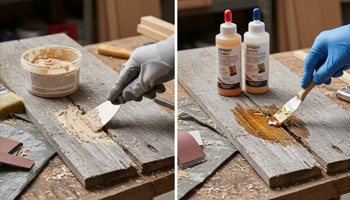Hardware & Fasteners
Choose fasteners and detailing that stop stains, resist corrosion, and keep joints sound. In this child category we compare metal types and coatings (hot-dip galvanized, 304/316 stainless, silicon bronze), wood/metal compatibility (cedar, redwood, ACQ-treated lumber), and repair tactics for stripped holes and weakened connections—so you fix the cause, not just the cosmetics.
Materials & Coatings That Last
Match metal to exposure and wood chemistry: 316 stainless for coastal and salt-spray zones; 304 stainless or hot-dip galvanized for general exterior; avoid electro-galvanized in wet or ACQ-treated environments. Keep dissimilar metals apart to prevent galvanic staining.
Read next: Nail & Screw Staining on Wood
Wood Compatibility (Tannins, Treatments & Stains)
Tannin-rich species (cedar, redwood, oak) blacken around plain steel and low-grade zinc coatings; pressure-treated lumber accelerates corrosion on the wrong hardware. Choose compatible fasteners and isolate copper-bearing flashings when needed.
Read next: Remove Stains from Wood Siding & Decks • Nail & Screw Staining on Wood
Detailing & Drainage at Connections
Most rot starts at connections. Elevate post bases, vent ledger interfaces, break capillary paths, and seal penetrations—then select hardware that sheds water instead of trapping it.
Read next: Soft Rot in Deck Posts
Cleaning Chemistry Around Metal
Oxidizers and chlorinated cleaners can speed up corrosion and drive staining if residues remain. Prefer fiber-safe cleaners and always rinse/neutralize before refinishing.
Read next: Best Deck Mildew Remover • Stain protocols: Remove Stains from Wood Siding & Decks
Repairing Stripped Holes & Damaged Fastener Zones
Decide whether to consolidate, fill, or replace based on remaining cross-section and load. Use penetrating consolidants to stabilize soft fibers, then shape with epoxy/filler and re-drill to proper pilot size; upsize hardware only when structure allows.
Read next: Wood Rot Consolidants • Wood Filler vs Epoxy for Exterior Repairs
Aesthetics: Preventing Halos, Streaks & Bleed
Pre-finish boards when possible, keep fastener heads flush, and use compatible putties/primers. Treat existing halos with the correct chemistry, then correct the hardware cause to avoid re-staining.
Read next: Nail & Screw Staining on Wood • Remove Stains from Wood Siding & Decks
Read next:
Material Longevity in Coastal Urban Architecture Coastal construction confronts accelerated deterioration from salt spray, humidity cycles, and UV exposure that compounds conventional weathering mechanisms. Material selection in these environments transcends aesthetic preferences or initial cost considerations—it determines whether buildings remain structurally sound and economically viable over multi-decade holding periods. The financial implications of premature material […]
Material Longevity Leer más »
Wood Filler vs Epoxy for Exterior Repairs: Weather Resistance Tested If you’re torn between “wood filler vs epoxy for exterior repairs,” here’s the blunt truth: in real weather, cheap wood filler usually buys you 18–36 months; a quality two-part epoxy, installed right, can cruise past a decade. I’ve redone hundreds of outdoor fixes because the
Wood Filler for Exterior Repairs Leer más »


